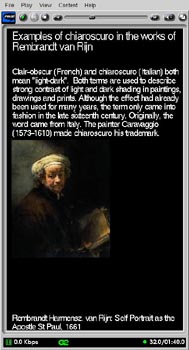
|
|
ERCIM News No.46, July 2001 [contents]
|
by Lynda Hardman
First generation web pages tend to be text-centric and created by hand for a broad audience. Second generation web pages offer some form of user-tailoring by extracting relevant content dynamically from a database and displaying it in a generic template. While this approach is already in use for creating textual documents, research carried out at the Multimedia and Human-Computer Interaction group at CWI aims at providing end-users with on-demand, user-tailored, synchronized hypermedia presentations.
The main goal of the research is to enable the dynamic generation of hypermedia documents that take into account user preferences and make optimal use of system and network resources. In order to achieve this we require to elevate multimedia to the same status as text in the way it can be included in documents and presented to a user. Multimedia document processing has a number of requirements that are fundamentally different from text which make it more difficult to incorporate in a ‘traditional’ electronic publishing environment. For example, multimedia document formatting cannot be based on text-flow layout rules. These differences make it extremely difficult to apply most commonly used solutions because they are too text specific. The reasons for wishing to tailor text documents to the needs of individual users, however, still apply to multimedia. Current trends are that the Web is accessed using appliances other than a standard PC, the primary mode need not be textual and the contexts in which the information is used are more diverse. Users are also becoming more demanding and expect content to be supplied in their own language and to take their cultural background into account. Our group has developed multimedia models and techniques that go beyond current text-centric approaches and can be employed to cater for the required diversity.
The approach that we are currently investigating is to generate individual, tailored documents on demand, based on the prevailing conditions, rather than having to rely on predicting these beforehand. The goal of our research is to construct an environment which allows variations in end-user platform, network conditions and user preferences to influence the multimedia document generation process.
The Cuypers Architecture
The Cuypers environment is a prototype hypermedia generation environment which is able to select media items from a database or the Web and combine them in a multimedia presentation. During the generation process, network conditions, discourse and interaction models, user preferences, and other varying conditions can be taken into account. The result of the process is the generation of a multimedia presentation that can be transmitted over the Internet and played to the user by a standard Web client. After the relevant media items have been retrieved, they need to be grouped into a coherent presentation that conveys the intended semantics of the author and is also adapted to the specific requirements of the user. In order to achieve an adequate level of adaptation, presentation independent abstractions are required to be able to generate a wide variety of hypermedia presentations while maintaining the underlying semantics. There are various levels of such abstractions, ranging from very high-level abstractions, that focus on the semantics but say little about the presentation-oriented details, to the presentation models used by concrete multimedia file formats.
Towards the Third Generation: Multimedia on the Semantic Web
Third generation Web pages will make use of rich markup, based on XML, along with metadata, eg encoded in RDF (W3C’s Resource Description Framework), to make the content not only machine readable but also machine processable. This will allow more directed search of documents, but also the development of new applications making use of the semantic information in the documents. E-commerce applications, for example, can make use of agreed-upon semantic mark-up to produce integrated information from several sources. In the medical world, patient records can be annotated using standard domain descriptions to allow their exchange among hospitals, and even countries.
 |
| Presentation explaining the chiaroscuro technique as used by Rembrandt, generated by the Cuypers system. |
In our work, we are interested in semantic markup to the extent that it potentially enriches the created hypermedia presentations and facilitates the presentation generation process. When media items are selected from databases we need information, for example, on the potential role the item may play in the integrated presentation. One of our research questions is to what extent this is possible, and what types of metadata actually improve the generation process.
Link:
http://www.cwi.nl/ins2/
Please contact:
Lynda Hardman and Jacco van Ossenbruggen — CWI
Tel: +31 20 592 4147
E-mail: Lynda.Hardman@cwi.nl, Jacco.van.Ossenbruggen@cwi.nl